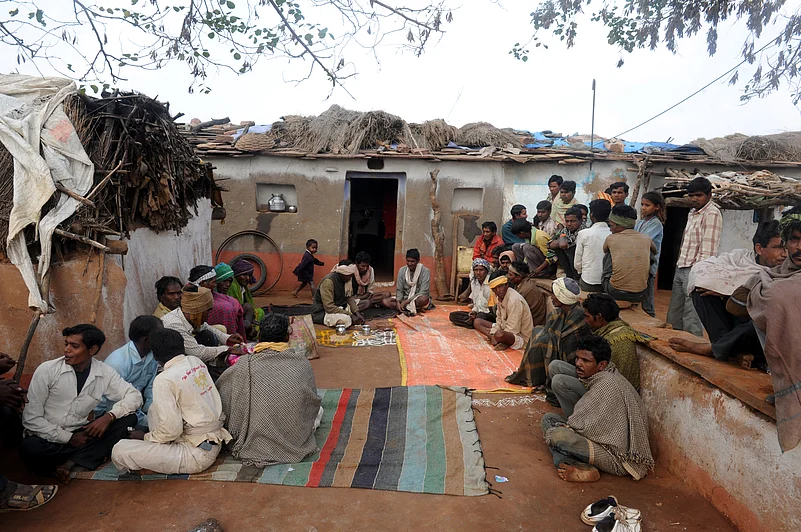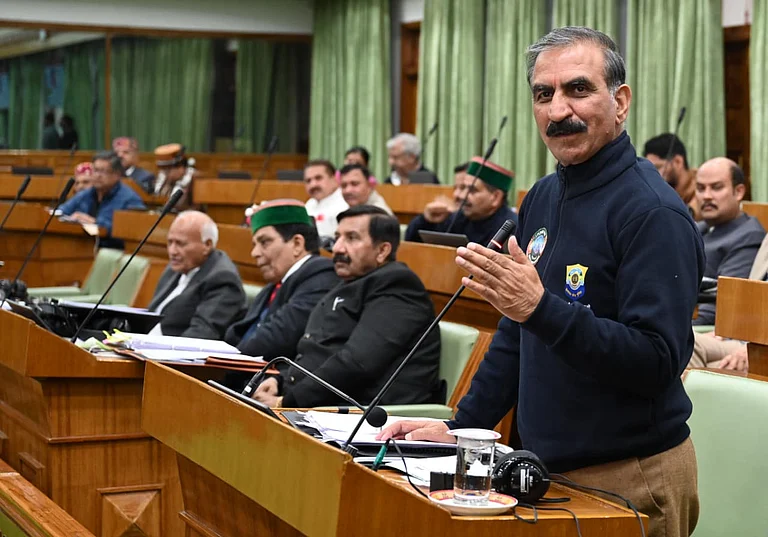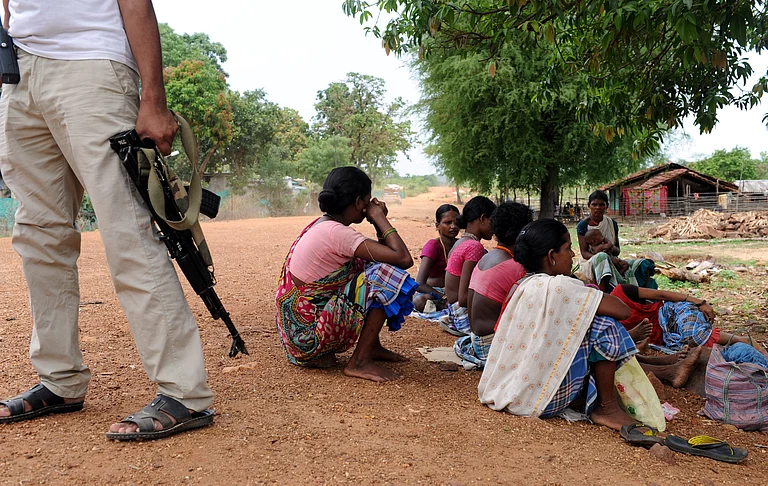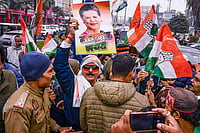
State policies have criminalised the Adivasi way of life; from the Wildlife Protection Act of 1972 to establishing the Central Proof Range, statutes are being used to turn ancestral forests into prohibited zones.
There is increasing militarisation in the forests, where land is being cleared for corporations and state ownership.
Women are at the forefront of the Adivasi and Dalit grassroots movements, which are challenging the silent violence of these statutes.
On a late summer afternoon, during a long phone call that drifted between memory and resilience, whether speaking of the Korkus and Rajbhars of Madhya Pradesh or the Adivasis of the Dangs in Gujarat, Irfan Engineer, the director of the Centre for the Study of Society and Secularism and a well-known activist for minority and tribal rights as well as a proponent of secularism, reflected on what it means to live under the gaze of the state. “In the year 1967,” he said, “the Adivasis of the Dangs would disappear into the forest whenever they heard the state surveyors were coming.
They weren’t running from the law; they were running from being seen.” He paused before adding, “The state calls it protection. But they are not protecting the forest, they are guarding it. That difference,” he said, “is where power and entitlement hide.”
The following context relates to the forest and what lies behind its dense foliage. It pertains to the Adivasis of the subcontinent and to how, since colonial independence, what has changed is not the condition of the forest but merely who dictates it. That inversion, where survival itself becomes trespass, sits at the heart of how India’s forest laws and militarised development have redrawn the meaning of belonging and progress. In villages around Hoshangabad, the same landscape that once offered sustenance and safety is now fenced by law, patrolled by guards, and shadowed by suspicion.
Echoes of Silence: Investigating the Death of Tribals in Hoshangabad grew out of this terrain of erasure. I wanted to return to the Hoshangabad district in Madhya Pradesh, to the forests where people once lived off the land and are now forbidden to enter, to understand what has really been happening to Adivasi communities here. It is a story about dispossession disguised as development, and about how silence itself becomes a weapon of the state.
Since the inception of the Central Proof Establishment in 1971, a crossbones danger sign has stood at its entrance, a warning that, over time, has come to symbolise the peril it brings to those living around it. In the nearby village of Kesla, where the range is located, Adivasi and Dalit communities have long sustained themselves by collecting scrap metal from the testing grounds. What began as a means of survival in the shadow of the state’s machinery of war has become a daily gamble with death.
The Central Proof Range at Itarsi was built as a testing ground where the Indian Army could trial its armaments and ammunition. Stretching nearly 20 kilometres in length and six kilometres in width, it is one of the largest proof ranges in the country. But behind this expanse of land lies a quieter, harsher story: land seized, forests fenced, and communities uprooted. The state government acquired stretches of forest and farmland, displacing generations of Adivasi and Dalit families. Those most affected were the Rajbhar, a caste group, and the Korkus, a tribal community. Since then, the area has remained under constant surveillance, with security posts at every corner, armed patrols circling the perimeter, and strict prohibitions against unauthorised entry during firing drills.
What was once justified as a measure of defence has become a story of exclusion. Here, the very people who have lived off this land for generations are treated as internal threats. Their existence, livelihoods, and sense of belonging have been fenced off, controlled, and rendered perilous.
Wildlife Protection: Is The Law Protecting, Or Does It Exclude Adivasis From Survival
When the Wildlife Protection Act of 1972 was passed, it was hailed as a milestone in India’s environmental history. In practice, however, it created a hierarchy of life in which forests and wildlife were to be protected while people were to be removed. The act criminalised daily practices that had long sustained Adivasi life: collecting Mahua flowers, grazing cattle, fishing, and harvesting bamboo. The different types of forests, such as reserved forests, protected forests, and village forests, have raised questions about the existence of Tribals, as these demarcations often encroach on their own land.
Forests have always been a collective property for the Adivasis and other local communities; they have never been individual property. The following demarcations raised a significant question about their entire existence, even during colonial times. As mentioned in the opening of this article, the adivasis used to hide from state surveyors in colonial times because they did not want to be taxed on their collective land, which was being used for data collection. Another important facet of this has been that any property not owned by an individual has been labelled as ‘state property,’ and the same has happened to the forests. Be it the forests of Gujarat or Madhya Pradesh or anywhere in the subcontinent.
“Criminalisation doesn’t mean it’s wrong,” Engineer explained. “It only means the state has found a way to control it.” Forest guards, once intermediaries between people and the state, became enforcers of exclusion.
“They are guarding the forest,” he said, “not conserving it.”
Adivasi communities, whose lives were built on collective ownership and self-reliance, were forced into a system that recognised only private or state property. “If something is not owned individually,” he said, “it automatically becomes state property. That is the logic of power.”
As forests were divided into zones and sanctuaries, freedom of movement, once taken for granted, became a legal risk. Even entry is a crime. In Hoshangabad, this transformation became violent with the establishment of the Central Proof Establishment, a testing range known as the “death range,” because of the casualties of the Adivasis who go to the range to collect the metal scrap from the remains of bombs and shells and sell it in nearby towns of metal markets of Indore, Moradabad, Aligarh and Bhandara, the site has uprooted 23 villages since its creation in 1971.
That inversion, survival itself branded as trespass, has shaped generations. A decade later, in the same region, another kind of resistance quietly unfolded. Professor Anil Sadgopal remembers it with precision. “This sugar is ours, not yours,” Dalit and Adivasi workers from Malhanwada shouted as they entered Palia Pipariya, a town in the Hoshangabad district of Madhya Pradesh, on one summer morning in 1981. The slogan reverberated through narrow lanes long dominated by the Palia caste. The Palias spat back, “Hum maalik hain iss ilaake ke. You are our slaves,” they said, the words heavy with centuries of entitlement. “That was the moment people stopped being afraid,” Sadgopal says. “The structure of caste cracked, even if only for a moment.”
That defiance was nurtured over a decade of careful work. In 1971, Sadgopal and a group of young scientists and teachers, many of whom were from IITs, relocated to the Bankhedi area of Hoshangabad district. The Madhya Pradesh government had granted them 150 acres for a period of thirty years. Professor Anil Sadgopal founded the Kishore Bharati organisation, which believed that education could be a form of liberation, rooted not in classrooms but in land, labour, and forests. They dug ring wells together, lowering concrete circles into the earth, each one deeper than the last. Water flowed where none had before. Fields yielded more. Slowly, people began to talk about land not as belonging to the state or the upper castes, but to those who worked on it.
Yet every act of creation was shadowed by the weight of authority. The Palia caste, whose name the town bore, had long extracted wealth from Dalits and Adivasis, first for the British and later for themselves. “They sensed we were building a world where their authority would mean nothing,” Sadgopal said. Even the police hesitated before the Palias, a reminder that caste and state violence often operate as one continuum.
Across the road lived the Rajbhar community, forest dwellers who cultivated lac, the resin that becomes bangles, varnish, and medicine. Rajbhars asked permission to grow lac on the land. Sadgopal replied, “You don’t need our consent. This is your land.” But the Rajbhars said: “The Palias will not let us.”
Kishore Bharati designated one acre to each of eighty families and planted trees across 120 acres. The forest became common again. When we leave this area, the 80 acres will belong to the Rajbhars — a moment when power was handed back rather than seized.
Other tribal communities also joined the Kishore Bharati. During one such gathering around Diwali, Professor Anil Sadgopal recalls that we called for a gathering to become more familiar with the Korkus in the area. One such Korku leader was Fag Ram. During this gathering, people from different castes were sitting together to eat, which was a somewhat alien concept to the Korkus and Rajbhars, both of whom were dominated by the Palias. One of the Korkus said, 'Is it legitimate to be part of this gathering and sit together, have food, then?'
A Gandhian activist friend of Sadgopal told the group: “Hum na apni jaati maante hain, na aapki.” We recognise neither our caste nor yours. Post the gathering, walking past the lac trees, one Korku man added, “Bolo, humari jaati kya? Humari jaati ka naam hai gareebi.” Our caste is poverty. Sadgopal called it “the most radical thing anyone could have said, and it’s revolutionary to say the least.”
Women played a central role in this quiet revolution. Tribal, Dalit, and working-class women questioned power in homes and fields alike. They attended meetings in their own languages, where education and dignity were inseparable. Mira Sadgopal, Anil’s wife, built a small library and documented the work of dais, the traditional midwives whose knowledge had been erased by formal medicine. Her later work with the Mahila Samakhya Programme drew directly from these beginnings, demonstrating that liberation requires recognising the labour, knowledge, and bodies of women.
Walking through Hoshangabad today is like walking through an echo. Many who once farmed these lands live displaced; others have disappeared.
The Silent Violence of Statutes
The Wildlife Protection Act illustrates what Engineer calls the “silent violence of statutes.” Unlike overt military repression, this violence is bureaucratic, quiet, and carried out through paperwork, permissions, and policing. “Brewing Mahua, grazing cattle, or gathering bamboo are not threats to nature,” he said, “but the law has made them threats to the state.”
In this system, forest guards exercise authority not through conservation but through surveillance. For many Adivasi families, even returning to ancestral forests to collect wood can lead to fines, arrests, or worse.
The hierarchy created by the Act, which privileges wildlife over humans, perpetuates a colonial logic: forests must be “saved” from their own people. It is conservation by displacement, a continuation of the empire under the language of ecology. “The law defends the voiceless, but in doing so, it silences the living.” In Madhya Pradesh, wild boars enjoy more legal protection than Adivasis and Dalits.
The Architecture of Exclusion
Speaking to Paramjeet Singh, an activist with the People’s Union for Democratic Rights (PUDR) and an occasional contributor with EPW, we spoke about how grassroots organisations like the Kisan Adivasi Sangathan (KAS) and the Kisan Mazdoor Samta Sangathan have tried to reclaim that lost sense of collective power among the Adivasis and Dalits of Hoshangabad district.
“These Sangathans,” he said, “are not just groups, they are classrooms.”
In their meetings, Dalits, Adivasis, students, and landless workers sit together, sharing food and stories. The aim is not only resistance but political education — to learn how to read power, to see the patterns behind their daily struggles, and to dismantle the structure of exclusion based on caste and muscle power, specifically from the dominant groups. According to Singh, the strength of these movements lies in their inclusiveness. “The state thrives on development projects whose base lies in giving the land to the big sharks for development projects. But when farmers, workers, and students stand together, that fragmentation collapses. That’s when real resistance begins.”
The establishment of the range, along with the Tawa Dam project, led to a people's movement demanding proper rehabilitation for the displaced tribal communities. In those gatherings, politics is not an abstract term. It is what happens when people realise that their hunger, their displacement, their invisibility are not accidents but systems.
Militarisation as Development
If the law is one face of control, militarisation in the forest is another. Ehtemam, an activist from the Forum Against Corporatization and Militarization, explained how security and development have become indistinguishable in tribal regions. They see the increasing presence of armed forces in tribal belts not as protection, but as a way to secure corporate interests. “The forests of Madhya Pradesh, Chhattisgarh, and Jharkhand are rich in minerals,” Badal, an activist of FACAM, said. “To access them, the state first needs to clear the people.” The process is systematic: first, a declaration of a protected area; then, eviction in the name of conservation; finally, the arrival of mining, dams, or industrial projects. Resistance is framed as anti-national, and dissent is framed as insurgency.
It is not development; it is an occupation of the land of tribals by the big sharks. In such landscapes, every act of living becomes subversive. To farm, gather honey, and brew Mahua, an act of survival became coded as threats.
The very assertion that surveys are viewed with suspicion by Adivasis stems from the fear that, after the surveys, their identity and land would be subjected to more restrictions, and the interests of big sharks would matter more to the state than the aspirations of the aboriginals. The fear of being taxed and the tax laws on the plough create another layer to this story. The British took the land from the indigenous people; today it belongs to the state. “The excise war,” or so-called excise laws on Mahua, further criminalise survival. Even in Wildlife Sanctuaries, entry is criminalised. Criminalisation does not always mean it is wrong.
The PUDR reports show how, in the forests of Hoshangabad, forest guards have repeatedly expected sexual favours from Adivasi women. While speaking to locals in and around the proof range, they described the systematic erasure of their trauma.
While speaking to Irfan Engineer, he recounted how he was arrested along with Vir Singh Vishram under the National Security Act. He said, “We did not build second-hand leadership for the movement for the Dangs in Gujarat. To talk about the shells and the bombs, we have to first talk about the alienation of tribals from their very own land. The draconian laws are enforced in such a way that no one can challenge them. I was arrested earlier as well; we did not anticipate such long periods behind bars. These are political issues.”
Engineer highlighted that the first citizens of Australia are the Aboriginal and Torres Strait Islander people. Indigenous peoples are entitled to their demands and existence. He said that Adivasis may not matter electorally, but they will be addressed. “We have encroached their land, and we owe them this.”
Adivasi Women at the Frontline
During my conversations with Professor Anil Sadgopal, founder of Kishore Bharati, educationist, activist, and also prominently known for his advocacy for the Right to Education Act, who has been living with the tribals of Palia Piparia since 1970 and knows the state of Hoshangabad intimately, I happened to ask the professor about the central role of Adivasi women in these struggles. “They are the spine of the movement,” he said.
Unlike the rigid patriarchal structures outside, tribal societies often operate with relative gender equality. Women cultivate fields, trade produce, and participate in community decisions. In the face of state repression, they have emerged as fearless defenders of their rights.
“They have been the first to confront the forest guards,” Engineer said, “because they are the ones who walk into the forest every day.” Their songs and rituals, often dismissed as folklore, are in truth political manifestos, expressions of resistance carried through melody and memory. These women have time and again threatened the forest guards when they have attempted sexual advances, using lathis and the forest wood logs they gather, often showing solidarity with each other against a patriarchal ethos that sees women as objects. These women remind us that the struggle for survival is not only about land but also about reclaiming the power to speak, to decide, to survive.
What Resistance Looks Like Now
Despite all the repression, a stubborn faith in continuity remains. “It will be done step by step,” Engineer said. “Adivasis will be there. We owe them this.” His words lingered like a vow. Across Hoshangabad, in villages ringed by barbed wire and forest boundaries, people still enter forbidden woods to collect firewood or tend their fields, quiet, daily acts of defiance.
In today’s India, where corporate ambition merges with state power and conservation often masks displacement, to survive is to resist. Every Adivasi who steps into the forest, every woman who brews Mahua, every child who asks why reclaims a small piece of freedom in a landscape that calls their living a crime.
Still, resistance continues. Grassroots organisations like Kisan Adivasi Sangathan and Kisan Mazdoor Samta Sangathan have become “classrooms of resistance,” where Dalits, Adivasis, students, and landless workers study power, solidarity, and strategy. The armed presence, ostensibly for development, masks corporate interests. “It’s not development,” Badal of the Forum Against Corporatization and Militarization said. “It's an occupation.” Women remain at the forefront. They walk into forests daily, brew Mahua, tend fields, and are coded as threats, but in reality, acts of defiance. Every Adivasi who steps into the forest, every woman who brews Mahua, every child who asks why, reclaims a small piece of freedom in a landscape that calls their living a crime.
Views and opinions expressed above are the author’s own.
The author is a researcher based in Delhi and hails from Madhya Pradesh. Her research interests lie in intersectional feminism, workers' rights, the rights of tribal entities, and the study of violence. She did her Master's at the Centre for the Study of Social Inclusion, Jamia Millia Islamia, New Delhi.

























